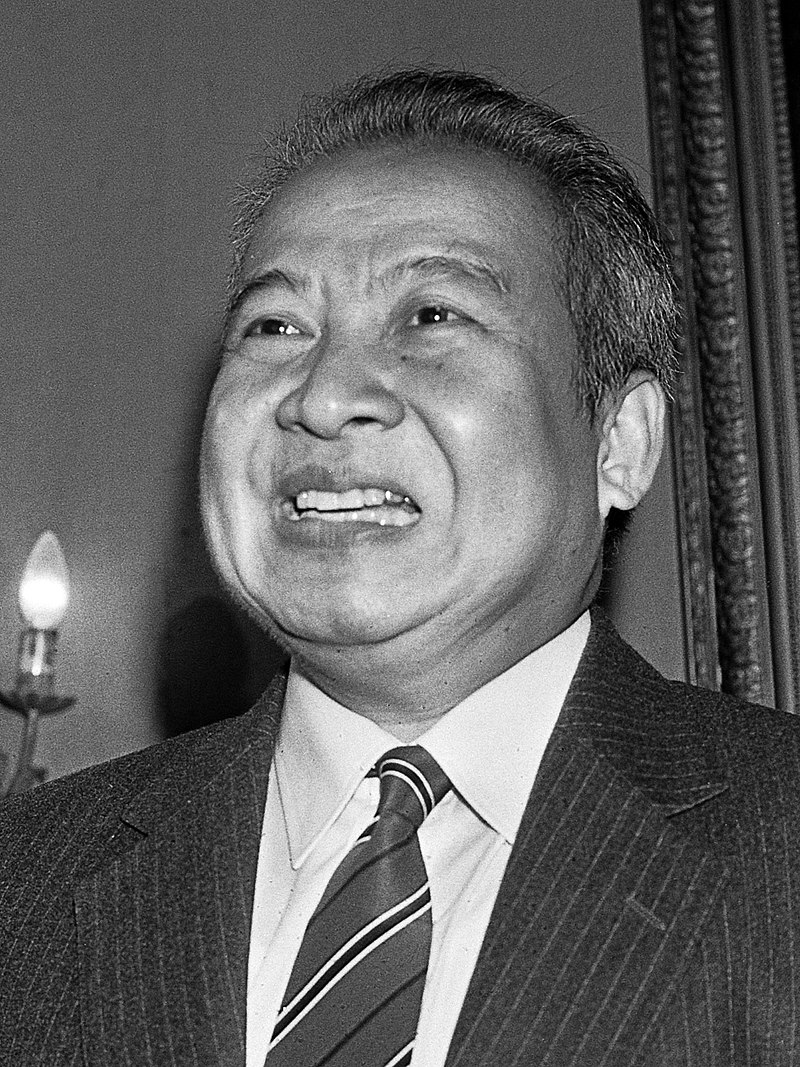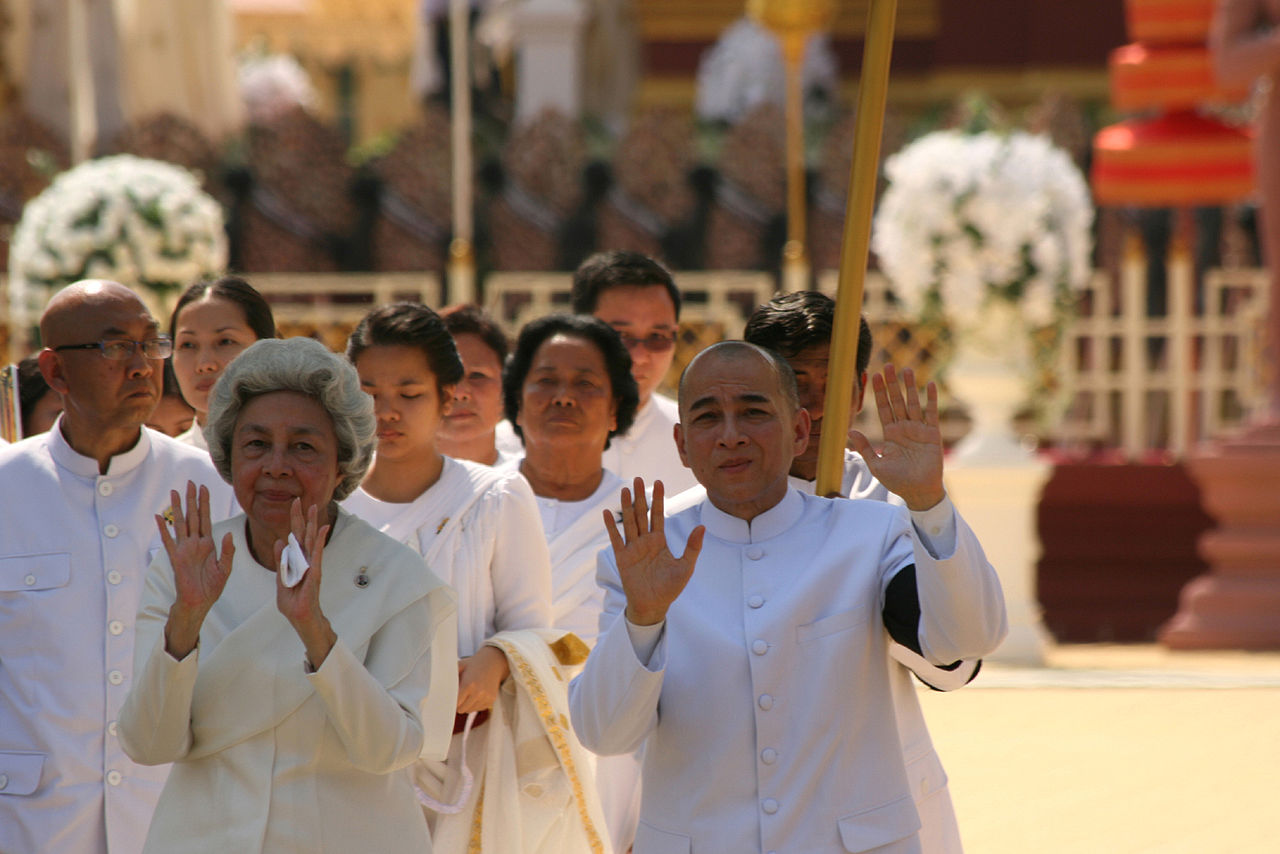by Susan Flantzer © Unofficial Royalty 2020

King Norodom Sihanouk of Cambodia; Credit – Wikipedia
Norodom Sihanouk reigned as King of Cambodia during two periods, 1941 – 1955 and 1993 – 2004. During his lifetime, Cambodia was the French Protectorate of Cambodia (until 1953), the Kingdom of Cambodia (1953 – 1970), the Khmer Republic (1970 – 1975), Democratic Kampuchea (1975 – 1979), the People’s Republic of Kampuchea (1979 -1993), and again the Kingdom of Cambodia (from 1993). Norodom Sihanouk also served as Prime Minister of Cambodia eight times between 1945 – 1962, Chief of State of Cambodia (1960 – 1970 and in 1993), and as President of the State Presidium of Democratic Kampuchea (1975 – 1976).
Note: In Cambodian naming practices, the surname comes first. The king’s surname is Norodom and his first name is Sihanouk, so he will be referred to as Sihanouk for the rest of the article.
Norodom Sihanouk was born on October 31, 1922, in Phnom Penh, Cambodia, then in French Indochina. He was the only child of Norodom Suramarit, King of Cambodia from 1955 – 1960 and Princess Sisowath Kossamak of Cambodia, daughter of King Sisowath Monivong of Cambodia and his wife Prince Norodom Kanviman Norleak Tevi.
Sihanouk had three half-siblings from his father’s third marriage to Kim-An Yeap (Khun Devi Kanha Subiya Yeap):
- Princess Norodom Vichara (1946 – 2013), married (1) Tep Sombana, no children, divorced (2) Yves Dumont, had one son
- Prince Norodom Sirivudh (born 1951), married (1) Keo Kosey, had one son, divorced (2) Christine Angèle Alfsen, one son and two daughters, divorced (3) Princess Norodom Norodom Veasna Diva of Cambodia
- Prince Norodom Preyasophon (born 1954), married Princess Vinayika Sisowath Vinak of Cambodia, had one son and one daughter
Sihanouk received his primary education at François Baudoin School and Nuon Moniram School in Phnom Penh, Cambodia. In 1936, Sihanouk was sent to Saigon, French Indochina, now Ho Chi Minh City, Vietnam for his secondary education at Lycée Chasseloup Laubat.

King Norodom Sihanouk in his coronation regalia; Credit – Wikipedia
On April 23, 1941, King Sisowath Monivong of Cambodia, Sihanouk’s maternal grandfather died. At the time, Cambodia was still a French protectorate and the French originally wanted Sihanouk’s father Norodom Suramarit to succeed him. However, Sisowath Monil, the son of King Sisowath Monivong, believed that he was the legal heir to the throne. The two royal families of Cambodia, the House of Norodom and the House of Sisowath, quarreled over the right to the throne. Finally, Jean Decoux, Governor-General of French Indochina, chose Suramarit’s 18-year-old son Norodom Sihanouk to be King of Cambodia because he was descended from both royal families. Sihanouk’s appointment as king was formalized by the Cambodian Crown Council and his coronation ceremony took place on May 13, 1941.
During World War II, Japan occupied Cambodia. After the end of the war, Sihanouk worked to gain Cambodia’s independence from France which was achieved in 1953. Sihanouk decided to abdicate in 1955 so he could directly participate in politics. He reverted to the title of Prince and was succeeded by his father Norodom Suramarit as King of Cambodia. Sihanouk’s political party Sangkum won the general elections in 1955 and he became Prime Minister of Cambodia.
Sihanouk was ousted by the Cambodian Coup of 1970. He fled to China and North Korea and formed a government-in-exile and resistance movement. He encouraged Cambodians to fight the new government and backed the Khmer Rouge during the Cambodian Civil War. Khmer Rouge was the name given to members of the Communist Party of Kampuchea. Kampuchea was the name Cambodia was known as from 1975 – 1990. The Khmer Rouge regime was highly autocratic, totalitarian, xenophobic, paranoid, and repressive. During the regime, hundreds of thousands of political opponents of the Khmer Rouge were murdered and its racist emphasis on national purity resulted in the genocide of Cambodian minorities. In 1975, after the Khmer Rouge’s victory, Sihanouk returned to Cambodia as a figurehead head of state. His relations with the new government declined and in 1976 he resigned. Sihanouk was placed under house arrest until the Vietnamese forces overthrew the Khmer Rouge in 1979 and the People’s Republic of Kampuchea was formed.
Sihanouk once again went into exile and founded the National United Front for an Independent, Neutral, Peaceful and Cooperative Cambodia, a royalist political party in Cambodia. After a long period of work and negotiations, the 1991 Paris Peace Accords were signed and the United Nations Transitional Authority in Cambodia (UNTAC) was established the following year. The UNTAC organized the 1993 Cambodian general elections, and a coalition government, jointly led by Sihanouk’s son Norodom Ranariddh and Hun Sen, was formed. A new constitution came into effect on September 24, 1993, and Sihanouk was reinstated as the King of Cambodia.
Embed from Getty Images
Norodom Sihanouk and his sixth wife Princess Monique in 1973
Sihanouk was married six times and had fourteen children. During the Khmer Rouge years, one of his wives, five of his children, and fourteen of his grandchildren disappeared. It is believed they were killed by the Khmer Rouge.
Wife 1: Phat Kanhol (1920 – 1969): A performer with the Royal Ballet of Cambodia, she married Sihanouk in 1941 and had one son and one daughter. Because of her background, the marriage was not recognized by the royal family. Under pressure from his grandfather, Sihanouk divorced Phat Kanhol in 1943. She remarried in 1944.
- Princess Norodom Buppha Devi (1943 – 2019), had four husbands and five children
- Prince Norodom Ranariddh (1944 – 2021), had two wives and four children
Wife 2: Princess Sisowath Pongsanmoni (1929 – 1974): The daughter of King Monivong, she married Sihanouk in 1941 and had four sons and three daughters. The marriage ended in divorce in 1951 and she remarried a lieutenant colonel.
- Prince Norodom Yuvaneath (1943 – 2021), had two wives and six children
- Norodom Ravivong (1944 – 1973), died from malaria
- Prince Norodom Chakrapong (born 1945), had seven wives and thirteen children
- Norodom Sorya Roeungsi (1947 – 1976), disappeared under Khmer Rouge regime
- Norodom Kantha Bopha (1948 – 1952), died from leukemia
- Norodom Khemanourak (1949 – 1975), disappeared under Khmer Rouge regime
- Norodom Botum Bopha (1951 – 1975), disappeared under Khmer Rouge regime
Wife 3: Princess Sisowath Monikessan (1929 – 1946): The daughter of King Monivong, she married Sihanouk in 1944. After giving birth to a son in 1946, she died from childbirth complications
- Prince Norodom Naradipo (1946 – 1976), disappeared under Khmer Rouge regime
Wife 4: Mam Manivan Phanivong (1934 -1975): She met Sihanouk at a dance party in Vientiane, Laos and they married in 1949 and had two daughters. After the Khmer Rouge captured Phnom Penh in 1975, Mam and her elder daughter disappeared and were most likely killed by the Khmer Rouge.
- Princess Norodom Sujata (1953 – 1975), disappeared under Khmer Rouge regime
- Princess Norodom Arunrasmy (born 1955), had two husbands and five children
Wife 5: Princess Norodom Thavet Norleak (1927 – 2019): Sihanouk’s aunt and cousin, she married him in 1955 and became the official First Lady of Cambodia. They had no children and divorced in 1968.

Queen Mother Norodom Monineath and her son King Norodom Sihamoni in 2013; Credit – Wikipedia
Wife: Norodom Monineath (born 1936): She was born Paule-Monique Izzi, the daughter of a French banker and a Cambodian woman. Sihanouk privately married her in 1952 and an official marriage took place in 1955. First known as Princess Monique, she took the name Monineath after Sihanouk divorced Norodom Thavet Norleak in 1968. After the abdication of her husband in 2012 and the accession of her son as King of Cambodia, she was styled Queen Mother of Cambodia.
- Norodom Sihamoni, King of Cambodia (born 1953), unmarried
- Prince Norodom Narindrapong (1954 – 2003), married had two children, died from a heart attack
Citing his poor health, Sihanouk announced his second abdication in October 2004. Unlike most monarchies, the succession to the Cambodian throne is not hereditary. The monarch is elected for life by the Royal Council of the Throne, made up of members of the royal family, government officials, and religious figures. Upon Sihanouk’s abdication, his son Norodom Sihamoni was unanimously elected as the next King of Cambodia on October 14, 2004. After his second abdication, Sihanouk became known as the King Father of Cambodia.
In August 2009, Sihanouk stated that he would stop posting messages on his website as he was getting old, making it difficult for him to keep up with his duties. From 2009 – 2011, Sihanouk spent most of his time in Beijing, China for treatment of colon cancer, diabetes, and hypertension. He returned to Cambodia in 2011 and made his last public appearance on October 30, 2011, celebrating his 89th birthday and the 20th anniversary of the Paris Peace Accords. Although Sihanouk intended to remain in Cambodia, he returned to Beijing in January 2012 on the advice of his Chinese doctors. A few months, later Sihanouk said he would not return to Cambodia for his 90th birthday. On October 15, 2012, Sihanouk died of a heart attack in Beijing, sixteen days before his 90th birthday.
Embed from Getty Images
King Norodom Sihamoni son of the late former King Norodom Sihanouk, and his mother, Queen Norodom Monineath grieve during the cremation ceremony on February 4, 2013
Sihanouk’s body was transported back to Cambodia on an Air China flight. 1.2 million people lined the streets of Phnom Penh between the airport and the palace. Sihanouk’s funeral and cremation were scheduled for February 2013. His body lay in state at the royal palace until February 1, 2013, when it was taken to the royal crematorium. Many foreign dignitaries gathered in Phnom Penh for the funeral and the cremation. On February 4, 2013, Sihanouk’s body was cremated. The next day, the royal family scattered some of Sihanouk’s ashes into the Tonlé Sap, a freshwater lake and an attached river that connects the lake to the Mekong River. The remainder of the ashes were kept in the palace’s throne room until July 2014, when Sihanouk’s ashes were interred in a stupa at the Silver Pagoda in Phnom Penh, Cambodia, next to the ashes of his daughter Princess Kantha Bopha who had died in 1952 when she was four-years-old from leukemia.

Stupa of Princess Kantha Bopha where the ashes of her father King Norodom Sihanouk were interred; Credit – By Engsamnang – Own work, CC BY-SA 3.0, https://commons.wikimedia.org/w/index.php?curid=7582446
This article is the intellectual property of Unofficial Royalty and is NOT TO BE COPIED, EDITED, OR POSTED IN ANY FORM ON ANOTHER WEBSITE under any circumstances. It is permissible to use a link that directs to Unofficial Royalty.
Works Cited
- En.wikipedia.org. 2020. Death And State Funeral Of Norodom Sihanouk. [online] Available at: <https://en.wikipedia.org/wiki/Death_and_state_funeral_of_Norodom_Sihanouk> [Accessed 16 August 2020].
- En.wikipedia.org. 2020. Norodom Sihanouk. [online] Available at: <https://en.wikipedia.org/wiki/Norodom_Sihanouk> [Accessed 16 August 2020].
- Royalark.net. 2020. Cambodian Royal Genealogy. [online] Available at: <https://www.royalark.net/Cambodia/camboa18.htm> [Accessed 16 August 2020].
- Zh.wikipedia.org. 2020. 诺罗敦·西哈努克. [online] Available at: <https://zh.wikipedia.org/wiki/%E8%AF%BA%E7%BD%97%E6%95%A6%C2%B7%E8%A5%BF%E5%93%88%E5%8A%AA%E5%85%8B#%E5%AE%B6%E5%BA%AD> [Accessed 16 August 2020].
